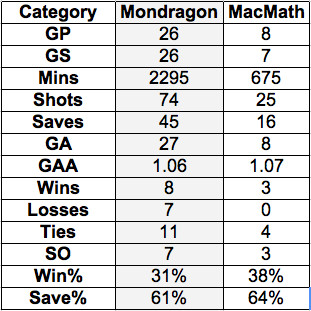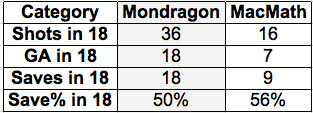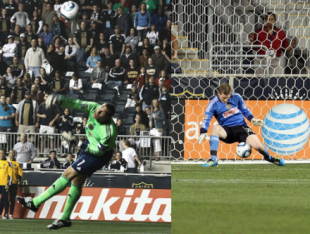Photos: Nicolae Stoian and Paul Rudderow
Before his injury, there was no question that Faryd Mondragon would be the starter between the posts the rest of the season for the Philadelphia Union. As a vocal leader and captain, not many people were thinking about the young backup Zac MacMath overtaking Mondragon’s starting job.
Of course, all this changed when Mondragon went down with an injury and the 20-year-old former Maryland keeper stepped in between the posts. MacMath rose to the occasion, settling in very well after giving up four goals to the last place New England Revolution in his first start.
My question is, who is the better keeper? Can we answer this by asking who has played better for the Union this season from a statistical perspective?
Standard GK stats comparison
Below is a table comparing the standard stats MLS records for keepers. Obviously, Mondragon has recorded more games played and minutes and so faced more shots and made more save. That aside, the Goals Against Average of both keepers are almost exactly identical. MacMath does hold an advantage in win percentage and save percentage.
 These statistics are all well and good, but we should take them with a grain of salt. First off, win percentage is highly dependent on how well the entire team is playing. One could easily argue MacMath’s advantage in win percentage has nothing to do with the young keeper, but instead is due to the Union playing better. The same argument could be used for goals against and goals against average. Maybe the Union defense has played much better recently, giving an advantage to MacMath? These are very hard questions to answer.
These statistics are all well and good, but we should take them with a grain of salt. First off, win percentage is highly dependent on how well the entire team is playing. One could easily argue MacMath’s advantage in win percentage has nothing to do with the young keeper, but instead is due to the Union playing better. The same argument could be used for goals against and goals against average. Maybe the Union defense has played much better recently, giving an advantage to MacMath? These are very hard questions to answer.
A more realistic stats comparison
Not all saves are the same, obviously. The save percentage of a keeper can be skewed by a team taking longer shots. A keeper can make an easy save off of a 40-yard shot, or they can make a heroic save off the line on a point blank header.
There are ways to better quantify a keeper’s form in a more accurate way. One way to differentiate between these different kinds of shots is to measure save percentage from shots taken within the box. Admittedly, this also is not perfect because one could argue not all shots within the box are the same, but it is a definite improvement over looking at just the save percentage as a whole. In this way we remove some of the factors that can skew save percentage to get a better measurement of keeper skill and talent.
I went through the Union Chalkboards on the MLS website to calculate these numbers in the data comparison chart to the right. As you can see, MacMath again holds an advantage, and this time it is slightly more of an advantage. Mondragon has saved half of the 36 shots taken inside the box he has faced, while MacMath has saved 56 percent of the 16 shots taken inside the box he has faced.
As you can see, MacMath again holds an advantage, and this time it is slightly more of an advantage. Mondragon has saved half of the 36 shots taken inside the box he has faced, while MacMath has saved 56 percent of the 16 shots taken inside the box he has faced.
Who Cares?
If you’re like me, you probably question how important the six percent difference in save percentage from shots inside the box really is. Well, think of it this way.
Opponents have taken 52 shots inside the Union box this season. With only one game remaining, let’s assume this is the total the Union faced this year. If we extrapolate and assume Mondragon played the entire season, the Union would have given up 26 goals from shots inside their box. Doing the same for MacMath, the Union would have given up just under 23 goals from shots inside their box.
As you can imagine, three goals does make a difference in the long run of the season. We can quantify what exactly a difference of three goals makes during the length of the season by using a formula to predict points based on goals for and goals against to show the predicted difference of three goals given up on the Union’s final points total. (If you’re interested in how it works, check out this link to my blog.) After plugging in each keeper’s respective numbers, we find a points total of 53 for Mondragon and 56 for MacMath. In other words, MacMath’s six percent edge in save percentage from shots inside the box equates to around one extra win for the Union.
Conclusion
I’ve done a bit of extrapolating to reach that last statement, but the point is clear: MacMath has had stronger goalkeeping numbers than Mondragon. Although it may not seem like a lot, the difference really is important in the long run of the season.
Statistics alone should not be the final word in deciding who is a better keeper, though. For example, there is no way to quantify Mondragon’s leadership and vocal abilities on the field, things that he definitely excels in. However, the numbers do tell us that, in the long run, a debate over who starts between the posts for the Union could become very real. At the very least, we know that behind Mondragon stands a young keeper with great promise for the future success of the Union.
Follow me on Twitter for more fun soccer data analysis: @SoccerStatistic


Im on team MacMath…let old dog lie…Lets train the pup to be a pack leader
MacMath will be on USMT and helping us win World Cup!! – Mark my words
Normally, jobs are not lost due to injury…in this sport, that is NOT the case. MacMath was RED HOT during his time as starter. He was thrown into the heat of the playoff race and he pretty much thrived in it. If it ain’t broke don’t fix it. I don’t think Mondragon should be thrown away either, but maybe we should have let MacMath play the season out. Who knows what would have happened in that Toronto match if he started. We might have won.
it’s great knowing that when Mondragon, who admittedly is getting up there in age, eventually retires, we will (hopefully still) have a young back-up ready to step in and be a franchise player for the U for years to come.
If you take away Mac’s first match at home in which he (and the defense) let in 4 goals, then his GPA looks much better then Mondragon… ; so I side with Mac as well.
Anyway, it is good that we have 2 good keepers entering the play-offs race.
Last season I would’ve killed to have this (good) problem. Between the grizzled vet leading the team in the short term, we have the uber-talented rook ready to step in when called upon.
Seitz who?